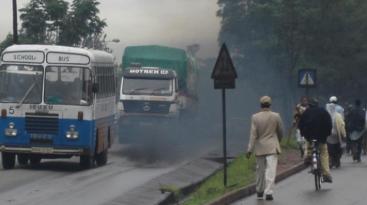By Baher Kamal*
How governments spend taxpayers money to subsidise fossil fuels that cause deadly air pollution – A reminder to mark 5 June World Environment Day.
Perhaps the most direct way to introduce this tough issue is what the United Nations secretary general, António Guterres, statedjust one week ahead of the 5 June World Environment Day, which focuses this year on air pollution, caused chiefly by the use of fossil fuels both in transport, industry and even household cooking, heating, etc.
“Subsidising fossil fuels means spending taxpayers’ money to “boost hurricanes, to spread droughts, to melt glaciers, to bleach corals: to destroy the world,” the UN chief warned, adding that “We need to tax pollution, not people.” “End subsidies for fossil fuels.”

How air pollution is destroying our health | WHO.
4.7 trillion dollars in global subsidies?
A corporation that knows much about money –the International Monetary Fund (IMF) estimates that, globally, subsidies remained large at 4.7 trillion dollars (6.3 percent of global GDP) in 2015 and were projected at 5.2 trillion dollars (6.5 percent of GDP) in 2017.
Its 2 May 2019 Working Paper Global Fossil Fuel Subsidies Remain Large, updates estimates of fossil fuel subsidies, defined as fuel consumption times the gap between existing and efficient prices (i.e., prices warranted by supply costs, environmental costs, and revenue considerations), for 191 countries.
“The largest subsidisers in 2015 were China (1.4 trillion dollars), United States (649 billions), Russia (551 billions), European Union (289 billions), and India (209 billion dollars),” it reports.
And it adds that “about three quarters of global subsidies are due to domestic factors—energy pricing reform thus remains largely in countries own national interest—while coal and petroleum together account for 85 percent of global subsidies.”

Air pollution and climate change: two sides of the same coin | UN Environment.
For its part, the International Energy Agency (IEA) reports that the value of global fossil-fuel consumption subsidies in 2017 is estimated at more than 300 billion dollars, higher than the estimate for 2016, which was around 270 billions.
The Energy Agency also alerts that “higher oil prices led to a partial rebound in total subsidy value in 2017, but the 12% rise in subsidies was considerably less than the 25% rise in oil price.”
The IEA provides this breakdown:
- In 2016, subsidies to electricity had overtaken those to oil, but in 2017 oil returned as the most heavily subsidised energy carrier.
- Oil subsidies accounted for 45% of the total, or nearly 137 billion dollars, covering an estimated 11% of global oil consumption.
- Natural gas subsidies were also significant, amounting to around 57 billion dollars, affecting the price paid for 23% of gas consumption.
- Coal subsides are relatively small, at 2 billion dollars in 2017.

The UK, Europe’s champion
Meantime, Sam Morgan on 15 January 2019 reported in EURACTIV.com that “the United Kingdom spends the most in the EU on subsidising fossil fuels, according to a new report by the European Commission, which also found that EU-wide payments have failed to decrease despite the bloc’s commitment to the Paris Agreement on climate change.”
“In 2016, the UK pumped more than 12 billion euro into fossil fuel support, closely followed by Germany, France, Italy and Spain. However, those countries actually then spent more on renewable energies like wind and solar than on coal, gas and oil.”
All in all, “fossil fuels enjoyed an estimated 55 billion euro in public funding across the EU, with the energy sector the biggest recipient, followed by the residential sector, industry and transport.”

Unsplash/Joshua Newton
The air we breath
In addition to diverting such huge amounts of taxpayers’ money to sustain major causes of greenhouse gas emissions –at the very cost of devoting them to public health, education and vital social services– there is the dramatic fact that air pollution levels remain dangerously high in many parts of the world.
New data from the World Health Organization (WHO) shows that 9 out of 10 people breathe air containing high levels of pollutants.
Updated estimations reveal an alarming death toll of 7 million people every year caused by ambient (outdoor) and household air pollution, the world top specialised body reported ahead of the 5 June World Environment Day.
“Air pollution threatens us all, but the poorest and most marginalised people bear the brunt of the burden,” says Dr Tedros Adhanom Ghebreyesus, Director-General of WHO.
“It is unacceptable that over 3 billion people – most of them women and children – are still breathing deadly smoke every day from using polluting stoves and fuels in their homes. If we don’t take urgent action on air pollution, we will never come close to achieving sustainable development.”

9 out of 10 people worldwide breathe polluted air, but more countries are taking action | WHO/Y. Shimizu
Key findings
On this, the World Health Organization provides the following data:
- The highest ambient air pollution levels are in the Eastern Mediterranean Region and in South-East Asia, with annual mean levels often exceeding more than 5 times WHO limits, followed by low and middle-income cities in Africa and the Western Pacific.
- Africa and some of the Western Pacific region have a serious lack of air pollution data. For Africa, the database now contains PM measurements for more than twice as many cities as previous versions, however data was identified for only 8 of 47 countries in the region.
- Europe has the highest number of places reporting data.
- In general, ambient air pollution levels are lowest in high-income countries, particularly in Europe, the Americas and the Western Pacific. In cities of high-income countries in Europe, air pollution has been shown to lower average life expectancy by anywhere between 2 and 24 months, depending on pollution levels.
Add to all the above that UN Environment reports that 92 per cent of people worldwide do not breathe clean air, that air pollution costs the global economy 5 trillion dollars every year in welfare costs, and that ground-level ozone pollution is expected to reduce staple crop yields by 26 per cent by 2030.

Desmond Simon | Unsplash
Death
WHO also estimates that:
- Around 7 million people die every year from exposure to fine particles in polluted air that penetrate deep into the lungs and cardiovascular system, causing diseases including stroke, heart disease, lung cancer, chronic obstructive pulmonary diseases and respiratory infections, including pneumonia.
- Ambient air pollution alone caused some 4.2 million deaths in 2016, while household air pollution from cooking with polluting fuels and technologies caused an estimated 3.8 million deaths in the same period, it explains.
- More than 90% of air pollution-related deaths occur in low- and middle-income countries, mainly in Asia and Africa, followed by low- and middle-income countries of the Eastern Mediterranean region, Europe and the Americas.
- Around 3 billion people – more than 40% of the world’s population – still do not have access to clean cooking fuels and technologies in their homes, the main source of household air pollution.
- Air pollution is a critical risk factor for non-communicable diseases, causing an estimated one-quarter (24%) of all adult deaths from heart disease, 25% from stroke, 43% from chronic obstructive pulmonary disease and 29% from lung cancer.

In Bangladesh, Women’s Right to Clean Air Starts in the Kitchen | Photo by UN Environment/ Prashanthi Subramaniam
Now, where does air pollution come from?
Regarding the major causes of air pollution, the United Nations reports that
- Household – The main source of household air pollution is the indoor burning of fossil fuels, wood and other biomass-based fuels to cook, heat and light homes. Around 3.8 million premature deaths are caused by indoor air pollution each year, the vast majority of them in the developing world.
- Industry – In many countries, energy production is a leading source of air pollution. Coal-burning power plants are a major contributor, while diesel generators are a growing concern in off-grid areas.
- Transport – The global transport sector accounts for almost one-quarter of energy-related carbon dioxide emissions and this proportion is rising. Transport emissions have been linked to nearly 400,000 premature deaths.
- Agriculture – There are two major sources of air pollution from agriculture: livestock, which produces methane and ammonia, and the burning of agricultural waste. Around 24 percent of all greenhouse gases emitted worldwide comes from agriculture, forestry and other land-use.
- Waste – Open waste burning and organic waste in landfills release harmful dioxins, furans, methane, and black carbon into the atmosphere. Globally, an estimated 40 percent of waste is openly burned.
- Other sources – Not all air pollution comes from human activity. Volcanic eruptions, dust storms and other natural processes also cause problems. Sand and dust storms are particularly concerning.
This scary information does not mean that taxpayers should stop contributing—everybody should continue doing it, sure.
But what about voting for those politicians who can hopefully show real, honest commitment to put an end to this mad practice of using public money to fund death?
——-

*Baher Kamal
Baher Kamal is an Egyptian-born, Spanish national, secular journalist, with nearly five decades of professional experience — from reporter to special envoy to chief editor of national dailies and an international news agency.
He is former Senior Advisor to the Director general of the international news agency IPS (Inter Press Service) and he also contributed to several prestigious magazines.
Baher Kamal is publisher and editor of Human Wrongs Watch , a non-profit, non-commercial mirror of “unseen” news and views. He is also member of TRANSCEND Network for Peace Development Environment and of Other News – Voices Against the Tide.
.
Read also:
These Aliens Are Here to Stay (And They Are Dangerous)
Long Life to Their Majesties, The Bees!
The Most Expensive 529 Billion Dollars
Libya: Up to One Million Enslaved Migrants, Victims of ‘Europe’s Complicity’
To Be a Latin-American Migrant in Madrid
To Be an Egyptian Migrant in Rome (and by the Way Make Great Pizza)
To Be a Nigerian Migrant in Italy
Climate Migrants Might Reach One Billion by 2050
Yemen: African Migrants Beaten, Starved, Sexually Violated by Criminal Groups
African Migrants Bought and Sold Openly in ‘Slave Markets’ in Libya
Mideast: Drought to Turn People into Eternal Migrants, Prey to Extremism?










